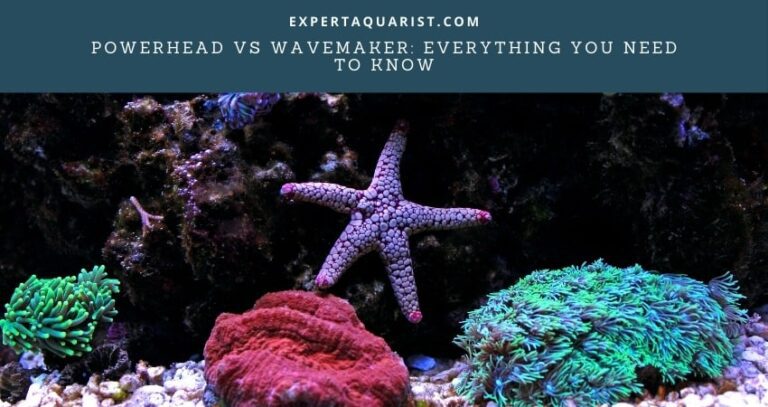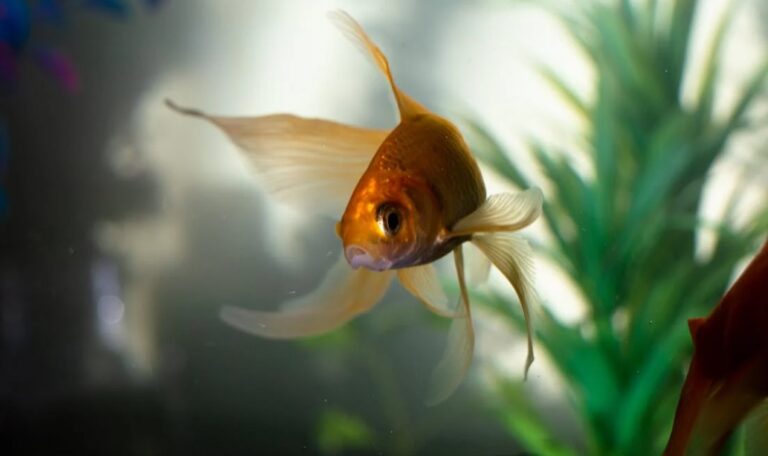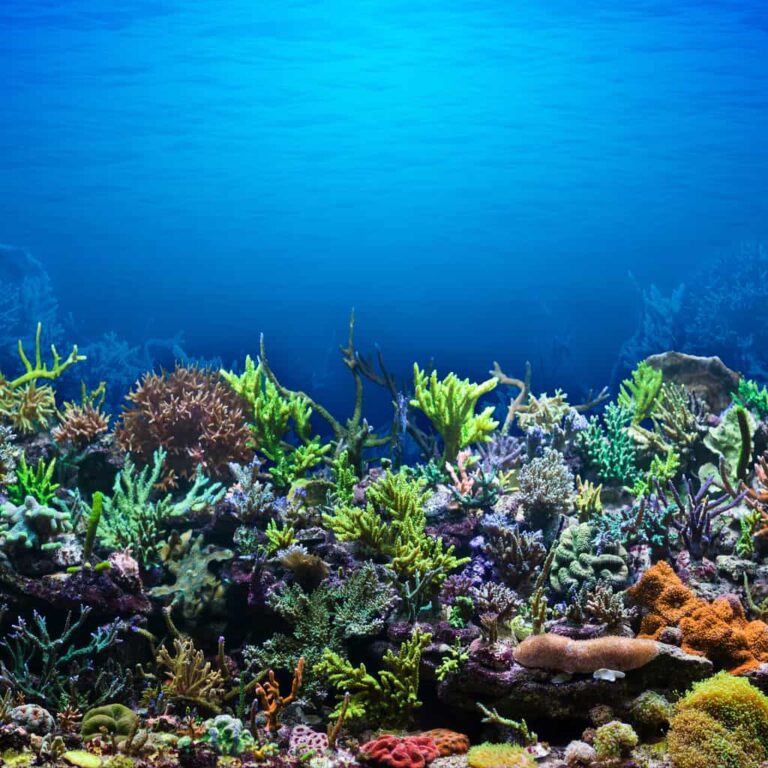Phosphorus, also referred to as phosphate by some, is a chemical element and mineral needed by most organisms for growth. Reef aquariums also require the presence of phosphate for the corals and fish to thrive. However, the proper phosphate levels for reef tanks must be achieved. Otherwise, it can lead to algae outbreaks.
Maintaining the right aquarium phosphate level is necessary for seasoned and beginner aquarists. This article is prepared to aid aquarists in achieving the perfect phosphate level and how to maintain it for healthy coral growth.

What Is Phosphorus?
Phosphorus plays an essential role in aquatic ecosystems. Its presence can make or break a healthy ecosystem inside a reef aquarium. Algae production may become excessive depending on the phosphate concentration inside the tank, which can disrupt a balanced aqua life.
Phosphorus serves as a building block for cellular energy for all aquatic organisms. Fish and coral thrive because of phosphorus. Fish, for example, eat phosphorus-rich foods, such as plankton and algae.
Phosphorus coming from these sources is considered organic phosphate. But, excess phosphate in a fish’s body must be excreted. When this excess phosphate is secreted, it becomes inorganic phosphate that mixes with the aquarium water.
The problem of every aquarist lies not in the organic material but in the many sources of this mineral, making it hard to control the phosphate level of reef aquariums.
Aside from the aquatic life in the tank, the tank water may also be a potential source of phosphate. Tap water, for example, makes a likely source of phosphate since water treatment plants use phosphates to protect pipes from rust and corrosion.
Since water lines are deep in the ground, underground minerals, including phosphate, can leach into the line and go directly to the aquarium, raising the tank’s phosphate level.
Accepted Phosphate Levels for Reef Tank
Phosphate is a crucial mineral needed by aquatic organisms inside reef aquariums. However, a high phosphate level does more harm than good. If left unchecked, a high phosphate concentration will build up inside the tank causing major problems.
What are the accurate phosphate levels for reef tanks?
Most recommendations for a reef tank phosphate level range from 0.02 to 0.05 ppm, depending on the kind of stony coral inside the aquarium.
In reefs with large stony polyp (LPS) corals, the phosphate level must not exceed 0.05 ppm, while a reef tank containing small stony polyp (SPS) corals must maintain a level below 0.03 ppm.
But then again, there is the issue that every reef tank is different. In new reef tanks around two to three years old, phosphates should be kept at a bare minimum to prevent any problems.
You may also wonder why some reef tanks can cater to high phosphate levels of around 0.1 ppm or more. If this is the case, the reef likely has several coral colonies. Such a reef tank is also home to diverse marine life. When all of these life forms work together, they can naturally keep phosphate levels under control.
How Do Phosphates Affect the Aquarium?
Studies show that phosphates are actually good for aquarium life. However, too much of it can result in nuisance algae growth, affecting the healthy growth of corals and other marine aquarium life.
Algae is good for the marine ecosystem since it serves as food for marine life. However, too much algae growth can disrupt the balanced ecosystem. The nuisance algae growth can lead to harmful effects such as overpowering corals leading to their death.
Too much phosphate inside a reef aquarium can also inhibit coral growth with or without algal problems. A phosphate level of more than 0.05ppm stops calcium carbonate precipitation.
Calcium carbonate is essential in the growth of certain corals such as Torches and Acropora. These corals use calcium carbonate to build their skeletons. So, if phosphate levels for a reef tank are above the normal rate, the corals may stop growing and eventually die.
Causes of Phosphates in Saltwater Tanks and Aquariums

Aquarium water laden with phosphates more than its intended amount contribute to unhealthy life inside the reef tank. Thus, you must know the major causes of increased phosphate levels in an aquarium to help stop it.
Poor Quality Water
One of the major causes of unwarranted high phosphate levels is the water used inside the aquarium. Tap water from unfiltered sources has high total dissolved solids (TDS). TDS consists of inorganic salts and other organic matter in small amounts. While a TDS level of 50 to 150 is healthy for human consumption, it is not good for aquarium life.
Fish Food
Using fish food gives your fish the nutrients it needs. While it is mostly organic phosphorus, it still contributes to a high phosphate level in the water. Flake food, for example, is high in phosphate. If the fish gets its fill, uneaten fish food breaks down and releases its phosphate content into the aquarium water.
Fish Waste
As said earlier, excess phosphate from the digested fish food is excreted into the water. The waste is further broken down upon excretion and releases its phosphate component into the water column. The more fish you have, the more fish waste there is. Thus, you need regular monitoring of your reef tank’s phosphate level to ensure it won’t exceed the accepted rate.
Testing for Phosphates in Aquarium Water
Testing the phosphate levels for a reef tank is made easier by the different test kits available on the market. Testing kits depend on the type of aquarium you have. A good test kit will measure the inorganic orthophosphate level of the tank water. Since test kits are not created equal, it is best to know the range and accuracy of the test kit you want.
Here are our top 3 picks for phosphate kits:
1. Aquacheck Phosphate Test Kit
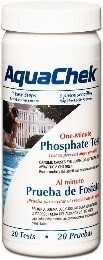
Aquacheck’s test kit for phosphate levels is easy to use and provides a quick result. It gives the result as fast as one minute. It measures phosphate levels from 0 to 1000 ppm.
2. Red Sea Fish Pharm Saltwater Phosphate Pro Test Kit
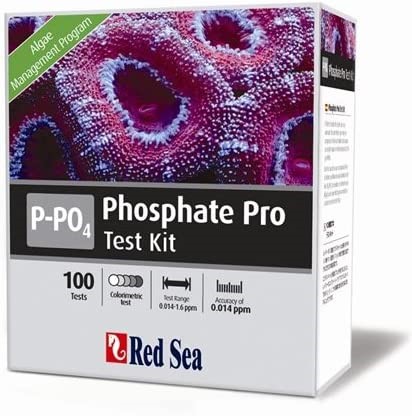
The Red Sea test kit uses advanced colorimetric technology. It measures phosphate in a saltwater aquarium accurately and with a high resolution.
3. API Phosphate Test Kit for Freshwater and Saltwater
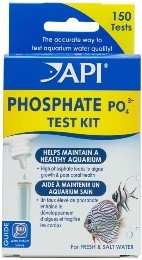
The phosphate test kit from API is very handy since it can measure phosphate levels for both freshwater and salt water. It has two color cards that accurately measure phosphate levels inside your reef tank.
Ways to Reduce Phosphate in Reef Tank
Weekly testing of water parameters is ideal. Seasoned aquarists do not rely on a single method to reduce the amount of water phosphate. Instead, they combine several trusted methods to help reduce and maintain phosphate at an appropriate and healthy level for fish and coral to thrive.
Knowing effective ways to reduce phosphate ensures that the marine life inside the aquarium maintains a balanced ecosystem. So, here are some tips for phosphate removal.
Liquid Phosphate Removers
Liquid phosphate removers such as Brightwell Aquatics and Continuum Aquatics are effective products in getting rid of excess phosphates. A liquid phosphate remover contains lanthanum that binds with the phosphate.
The bonded particles cause the aquarium to be cloudy. Hence, it should be removed through mechanical filtration. This method of reducing phosphate levels must also be combined with protein skimming to be effective.
Filter Media
Fluval ClearMax Phosphate Remover is an example of a chemical filter media. ClearMax is a science-grade resin that absorbs phosphate, nitrite, and nitrate. Other filter media use granular ferric oxide, while some add aluminum oxide to their formulas.
Protein Skimmer
Protein skimmer works by removing organic matter even before it can create havoc. It eliminates dissolved matter before it has the chance to release its phosphate component into the water by using air bubbles that flow upwards together with waste and proteins to be collected.
Refugiums
A refugium with macroalgae helps remove phosphate. The most popular macroalgae among expert aquarists and hobbyists are Caulerpa and Gracilaria.
Algae Scrubbers
An algae reactor or algae scrubber has a similar mechanism as that of macroalgae. However, in this method, you grow microalgae on a screen. The tank water will flow into the screen and hold onto the phosphate. You must remove the turf algae from the scrubber, so it won’t grow excessively.
Carbon Dosing
Using the carbon dosing technique helps maintain a balance of nitrate and phosphate levels within the reef tank. Brightwell Aquatics Reef BioFuel is a carbon source for marine aquariums and reef tanks.
It maintains the balance in the aquatic ecosystem by assisting in microbial growth and reproduction so that these bacteria can consume nitrate and phosphate from the water. The organisms are then removed from the tank through protein skimming.
Bio Pellets
Bio pellets use natural corn-based plastic media to promote bacterial growth. As soon as the microorganisms grow, they consume the excess phosphate and nitrate from the water. And just like in carbon dosing, these bacteria are removed from the aquarium using the protein skimming method.
Regular Cleaning and Water Change
Though water change and cleaning alone cannot help in phosphate control, they still play vital roles in reducing phosphate levels. Water should be replaced with RO/DI clean water so that the water is free from TDS.

